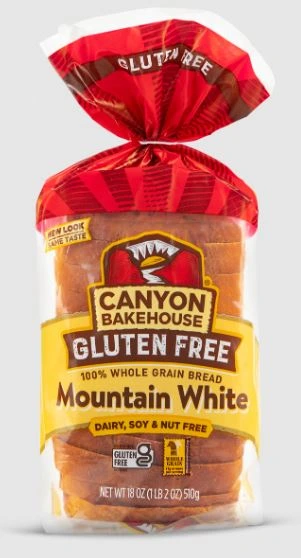The world of gluten-free bread has expanded significantly, offering many delicious alternatives for those steamed of gluten. This guide reveals the best gluten-free bread options and top brands.
Read more About Bread 101: An Overview of Different Types & Uses.
The Rise of Gluten-Free Breads
Gluten-free breads have surged in popularity, not just for those with celiac disease but for health-conscious consumers in general. Here’s a deeper look at their benefits and what makes them stand out.
What Bread is Gluten-Free? Ingredients to Look For
Gluten-free breads avoid wheat, rye, and barley—common gluten sources. Instead, they might use ingredients like brown rice flour, sorghum flour, or even amaranth. The absence of traditional wheat flour doesn’t mean a compromise on taste. With the right mix of flours, seeds like sunflower and flax, and other natural ingredients, these breads can be just as flavorful.
The Difference in the Baking Process
Gluten-free bread baking requires precision. While traditional breads rely on gluten for structure, gluten-free options often use xanthan or guar gum. Ingredients like yeast, sugar, and salt remain essential, but baking soda, eggs, or even vinegar might be added for texture and rise.
Best Brands and Products on the Market
With numerous brands offering gluten-free breads, the options might feel overwhelming. Here’s a list of some of the top brands that have garnered stellar reviews and a dedicated following.
Canyon Bakehouse
A powerhouse in the gluten-free world, Canyon Bakehouse offers a variety of slices, from their classic white bread to a delightful 7-grain loaf. Packed with seeds, grains like quinoa and millet, their breads are both nutritious and delicious.
Udi’s Gluten-Free
Another giant in the gluten-free industry, Udi’s boasts breads with impeccable texture and flavor. Whether you’re after a classic sandwich bread or a hearty whole grain loaf, Udi’s has it all.
Little Northern Bakehouse
For those who appreciate seeds and grains in every bite, Little Northern Bakehouse should be on your list. With a focus on fiber-rich ingredients like flax and sunflower seeds, their breads are both tasty and wholesome.
Read more About How to Make Bread Flour at Home Easily and Quickly.
Making the Right Choice: Things to Consider
Picking the perfect gluten-free bread involves more than just checking the “gluten-free” label. Here are some factors to consider when making your choice.
Ingredient Quality and Nutritional Content
Apart from the absence of gluten, scrutinize the ingredient list for whole foods and minimal additives. High fiber content, minimal sugars, and the inclusion of nutrient-rich seeds and grains are signs of a top-quality product.
Price and Availability
While gluten-free products tend to be pricier, some brands offer competitive prices without compromising on quality. Moreover, with gluten-free breads becoming mainstream, availability in local stores has improved.
Personal Preference on Texture and Flavor
Everyone’s palate is unique. Some prefer a nutty, seed-rich bread, while others might lean towards a soft, sandwich-like texture. Always consider personal flavor and texture preferences when choosing a brand.
Home-baked vs. Store-bought: What’s the Difference?
While store-bought gluten-free breads offer convenience, there’s a growing community of home bakers venturing into gluten-free baking. Let’s delve into the pros and cons of each.
Control Over Ingredients in Home-baking
One of the primary advantages of home baking is control. You decide what goes into your bread. From organic brown rice flour to non-GMO sunflower seeds, the choices are endless. Plus, for those with additional dietary restrictions, such as avoiding soy or dairy, homemade bread provides an unparalleled level of customization.
Freshness and Flavor
There’s nothing quite like the aroma of freshly baked bread wafting through your home. Home-baked breads don’t have preservatives, ensuring you’re consuming them at their peak freshness and flavor.
Convenience of Store-bought Brands
While home baking offers freshness and control, store-bought breads win in the convenience department. Brands like Canyon Bakehouse or Udi’s have perfected their recipes, offering consistent taste and texture. They’re also readily available, making them perfect for those on-the-go moments.
Gluten-free Bread Trends to Watch
As the demand for gluten-free products rises, so does the innovation in this sector. Here’s a look at the trends shaping the gluten-free bread market.
Sourdough Varieties
A classic in the bread world, sourdough is making its mark in gluten-free variants, too. Using a mix of gluten-free flours and traditional fermentation processes, gluten-free sourdough offers a tangy flavor profile beloved by many.
Seed-rich and Multi-grain Options
With health at the forefront, brands and home bakers are incorporating a plethora of seeds and grains into their breads. Think chia seeds, hemp seeds, and a mix of millet, quinoa, and amaranth for added nutrition and texture.
Eco-friendly Packaging
As consumers become more environmentally conscious, gluten-free bread brands are pivoting to sustainable packaging options. This shift not only caters to the demand for gluten-free but also for eco-friendly products.
Frequently Asked Questions
Is yeast used in all gluten-free breads?
While many gluten-free breads use yeast, some recipes might use baking powder or soda for leavening.
Can I freeze gluten-free bread?
Yes, many gluten-free breads freeze well, extending their freshness for future consumption.
Are there gluten-free breads with high protein content?
Absolutely! Some brands use ingredients like quinoa or nuts, increasing the protein content.
Is gluten-free bread keto-friendly?
Some might be, but always check carbohydrate content if following a strict keto diet.





